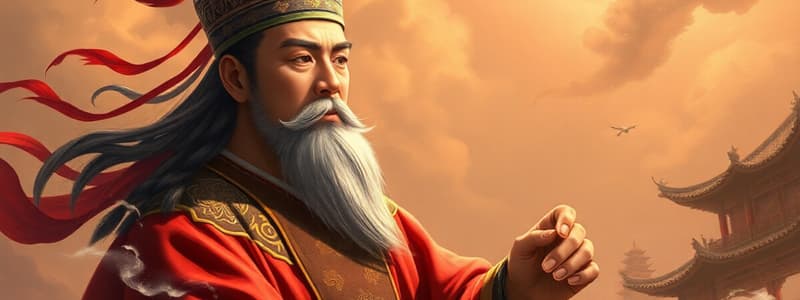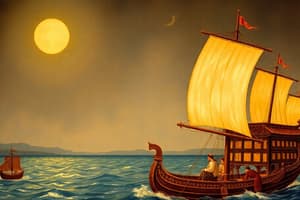Podcast
Questions and Answers
Who was the founder of the Ming Dynasty?
Who was the founder of the Ming Dynasty?
- Kangxi
- Yong Lo
- Hong Wu (correct)
- Zheng Ho
What action did Yong Lo take regarding the expeditions of Zheng Ho in 1433?
What action did Yong Lo take regarding the expeditions of Zheng Ho in 1433?
- He halted the expeditions. (correct)
- He funded more maritime projects.
- He increased trade with Europe.
- He expanded the expeditions.
What socioeconomic status did merchants have in Ming China compared to peasants?
What socioeconomic status did merchants have in Ming China compared to peasants?
- Higher than peasants in all respects.
- Higher than peasants in Confucian ideals.
- Equal to peasants in terms of production.
- Lower than peasants in Confucian ideals. (correct)
What led to the fall of the Ming Dynasty in the 1600s?
What led to the fall of the Ming Dynasty in the 1600s?
What was the primary reason for the Chinese policy of isolationism during the late Ming Dynasty?
What was the primary reason for the Chinese policy of isolationism during the late Ming Dynasty?
Which dynasty succeeded the Ming Dynasty in China?
Which dynasty succeeded the Ming Dynasty in China?
How did the Dutch impact the region in the 1700s?
How did the Dutch impact the region in the 1700s?
What was a requirement for foreign traders wishing to engage in trade with China?
What was a requirement for foreign traders wishing to engage in trade with China?
Who was the last emperor of the Qing Dynasty?
Who was the last emperor of the Qing Dynasty?
Which significant event occurred due to British refusal to perform Kowtow?
Which significant event occurred due to British refusal to perform Kowtow?
Flashcards
Ming Dynasty
Ming Dynasty
Chinese dynasty that overthrew the Yuan Dynasty, established by a peasant.
Zheng He's Expeditions
Zheng He's Expeditions
Large-scale voyages of exploration by the Chinese admiral Zheng He during the Ming dynasty.
Ming Isolationism
Ming Isolationism
Policy of limiting Chinese overseas exploration and trade, especially with Europe.
Qing Dynasty
Qing Dynasty
Signup and view all the flashcards
Kowtow Ceremony
Kowtow Ceremony
Signup and view all the flashcards
Yongle Emperor
Yongle Emperor
Signup and view all the flashcards
Forbidden City
Forbidden City
Signup and view all the flashcards
Kangxi Emperor
Kangxi Emperor
Signup and view all the flashcards
Qianlong Emperor
Qianlong Emperor
Signup and view all the flashcards
Opium Wars
Opium Wars
Signup and view all the flashcards
Study Notes
Ming and Qing Dynasties: China
- Mongol Rule and the Ming Dynasty: The Mongols formed the Yuan Dynasty, but the Chinese ousted them, establishing the Ming Dynasty. Hongwu, a peasant, founded the Ming. His son, Yongle, continued the dynasty.
- Zheng He's Voyages: Yongle sponsored Zheng He's maritime expeditions, reaching India with large Chinese ships called junks.
- Ming Isolationism: After 1433, Yongle halted the expeditions, China adopted a policy of isolationism toward overseas exploration and trade with Europe. This was partly due to self-sufficiency (silk, spices, tea) and a differing approach to resources (compared with colonization).
- Trade Restrictions and Economy: The Chinese established regulated ports for European trade, imposing heavy taxes. This sparked a black market, but the Chinese socio-economic status still placed merchants below peasants in Confucian ideals, despite their economic importance. Built Forbidden City, reflecting Daoist principles.
- Decline of the Ming and Rise of the Qing: Corruption, heavy taxation, and outside invasions led to the Ming Dynasty's weakening and eventual downfall in the 1600s. The Manchus (Jurchens) invaded and established the Qing Dynasty.
- Qing Dynasty's Prosperity: The Qing, the last Chinese dynasty, experienced significant prosperity from the 17th-18th centuries, with powerful leaders like Kangxi and Qianlong.
- Qianlong and Western Interactions: Qianlong (a notable leader of the Qing) refused British trade requests because they did not perform the kowtow custom. He sent a dismissive letter. The British sought tea (and to avoid kowtow) and later trafficked opium into China. This contributed to China's vulnerability towards foreign powers.
- Kowtow: The custom of Kowtow demanded bowing to the ruling figure. This was a crucial part of interactions with the Chinese.
- Qing Peak: Qianlong ruled during the height of the Qing Dynasty. The dynasty saw population booms and significant societal changes.
Tokugawa Japan (Information provided in a different text fragment needed to make notes)
(No information is provided for Tokugawa Japan in the current source material).
Studying That Suits You
Use AI to generate personalized quizzes and flashcards to suit your learning preferences.




